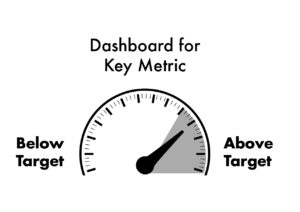Top Three Biggest Customer Acquisition Mistakes – Part 2
Mistake #2: Under-investing in Analytics
Picture this: You launch your new online business with great energy and excitement and start doing a million and one things to improve the site and gain awareness. However, we have seen over and over that teams often spend 98% of their time on things that have little impact, while they under-invest in the few projects that really matter. This is where analytics come in.
Let’s use a fictional ecommerce company, Bob’s Hats. Potential investors want to see Bob’s Hats hit $1MM per year in revenues. The first step is to develop a rough marketing model that shows how to get to $1MM a year. In this case, let’s assume the company has just launched and has some data from a handful of beta customers. (If the company wasn’t live, they could go through the same exercise, but just would have to make assumptions for all the data points we are going to review).
Let’s work backwards and describe all the intermediate metrics Bob’s Hats should be watching:
- The company has some early data that says that new customers on average place one order per year for $50. Hence, the company needs 20,000 customers to place an order in its first year to hit its revenue target.
- The company has also seen that only 50% of the customers who put something in the cart actually check out. In other words, it needs to have 40,000 customers put something in the cart.
- Only 10% of the early customers who visit the site will put something in the cart. In other words, the company needs 400,000 people to visit the site in order to have 40,000 put something in the cart.
We now have a very rudimentary funnel. Acquiring customers is all about managing the funnel.
The next step at Bob’s to make sure you have dashboards that provide you easy access to the following:
- Number of visitors coming to the site with a focus on whether you are getting to 400,000 people per year
- Number and percent of people putting something in their cart. Are we on track to hit 40,000 people who put something in their cart this year?
- Number of orders. Taking into account seasonality, will we see 20,000 customers place an order this year?
- Average order value. Is the $50 target accurate?
- Revenue with a clear projection to see if we are going to hit $1MM for the year
Once you have these dashboards set up, you can watch customers flow through the site, and you will have a clear picture of where any issues are in the process. For example, if you have UX issues in part of your site, the dashboards will immediately illuminate the issues and you can jump on them before you burn too many marketing dollars and cycles.
The next step is to ensure that you have robust web analytics set up so you understand which marketing programs are driving which customer orders. For each of the metrics above, you want to know which site, campaign, and ad was responsible. You then can figure out the return on investment for each marketing program. For example, for every dollar you spend on paid Facebook ads, how much profit do you get from orders? Once you have that figured out, you can see which marketing programs are most effective. You will also be able to tune your ads and refine your targeting to just those customers that are most profitable.
The best time to set up these analytics is before you launch. Once you launch, it can be hard to find the time because you are so busy. However, if you didn’t set up the analytics before launch, it is time to put the brakes on marketing until you have these analytical tools running smoothly. If you are a nimble shop, you can get some solid reporting running in a matter of weeks. Once you are done, you will often realize that 90% of what you were doing before wasn’t optimal, and quickly re-balance. Yeah, it was a pain to put things on hold for several weeks while you got your analytics set up, but the payback will be almost immediate if you find out that only a handful of your marketing efforts were producing the lion’s share of your results.
This post is an excerpt from How to Acquire Your First Million Customers by Ken McDonald and Chris Newton, two Internet execs who have grown multiple companies to over 10 million customers. Get your copy of the book to learn more proven customer acquisition tips and techniques.
